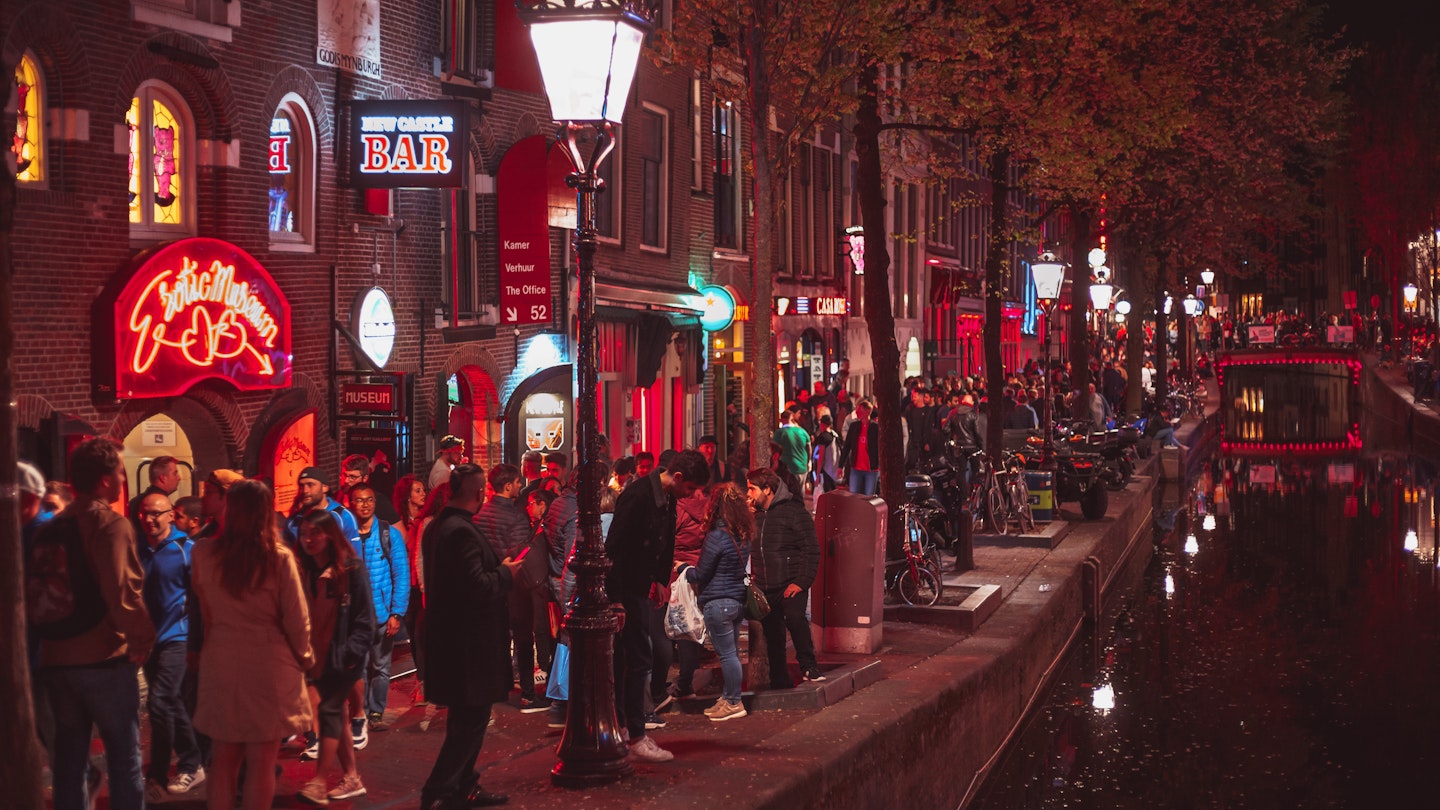Amsterdam’s infamous Red Light District is a carnival of vice, with skimpily-clad commercial sex workers in brothel windows, raucous bars, haze-filled ‘coffeeshops’, strip shows, and mind-boggling museums. It’s not for everyone.
If you choose to satisfy your curiosity with a wander around the area, keep your wits about you and watch out for pickpockets. Most importantly, remember that there’s more to the Red Light District than its salacious nature and much more to this multifaceted city than the Red Light District.
The Red Light District—a warren of medieval alleyways making up the inner-city area locally known as De Wallen—is just southeast of Centraal Station, on and around the parallel neon-lit canals Oudezijds Voorburgwal and Oudezijds Achterburgwal; Warmoesstraat is home to the district’s main gay action.
Red Light District Background
A major trading harbour since the Middle Ages made Amsterdam a magnet for the ‘world’s oldest profession.’ As early as the 1300s, women carrying red lanterns (due to their flattering light) met sailors near the port, and bars, clubs, and risqué entertainment venues flooded into the area. However, sex work wasn’t legal until 1810, and brothels weren’t legalized until 2000.
Changes continue: since 2007, city officials have taken measures to clean up the district by reducing the number of red-light windows in an effort to eliminate pimps, human traffickers, and money launderers (all of which are illegal). Project 1012, named for the area’s postal code, encourages fashion studios, art galleries, cafes, and other creative enterprises to set up here. Moreover, in 2013, the council raised the minimum age for sex workers from 18 to 21 and introduced mandatory red-light window closing hours between 6 am and 8 am. In 2020, tourists to Amsterdam will no longer be able to take a tour of De Wallen. It’s a measure designed to combat overtourism, but sex workers have come out against the plan.
Sex Work
Despite the changes, more than 290 red-lit window brothels remain, and the industry generates about €650 million annually, according to the Central Bureau of Statistics (yes, commercial sex workers pay taxes).
Ground-zero for red-light windows is, ironically enough, Amsterdam’s oldest building, the 14th-century Oude Kerk (Old Church). Near its entrance, look down to see the ‘golden torso’ pavement plaque of a hand groping a breast. On the Oudekerksplein is Belle, a bronze statue of a sex worker with the inscription ‘Respect sex workers all over the world.’ Just nearby, the Prostitution Information Centre is a fount of information for both sex workers and visitors and runs informative walking tours twice a week.
Need to know:
- Don’t photograph or film sex workers in the windows—out of respect, and to avoid having your camera flung in a canal by their enforcers.
- On the De Pijp neighbourhood’s western border along Ruysdaelkade, there’s a second, smaller district with a strip of red-light windows (minus the stag parties and drunken crowds).
Museums
Opened in 2014, the brothel-turned-sex work museum Red Light Secrets gives you a unique behind-the-scenes glimpse into the profession. You can check out bondage exhibits and other eyebrow-raising displays at the Red Light District’s Erotic Museum or, for more raunchy exhibits, head northwest to the Sexmuseum Amsterdam, located between Centraal Station and Dam Square.
Learn everything you ever wanted to know about hash, marijuana, and hemp at the eponymous Hash, Marijuana & Hemp Museum.
Coffeeshops
Coffeeshops (i.e., cannabis cafes) exist throughout the city and country, but the Red Light District has an especially high concentration. Greenhouse and Baba are two of the area’s most popular locations. Cannabis is not technically legal in the Netherlands, but the possession and purchase of 5 g of ‘soft drugs’ (i.e., marijuana, hashish, space cakes, and truffles) is widely tolerated, and users won’t be prosecuted for this amount.
The most potent cannabis varieties contain 15% tetrahydrocannabinol (THC), the active substance that gets people high (anything above 15% is classified as a hard drug and therefore illegal). Therefore, if you do partake, always exercise caution; even many regular smokers can’t stomach the local product. The Red Light District’s Cannabis College has reams of information.
The lowdown:
- Drinking alcohol and smoking tobacco (whether mixed with marijuana or on its own) in coffeeshops is illegal.
- Don’t ask for hard (illegal) drugs.
- Never buy drugs of any kind on the street—fatalities can and do occur.
Drinking and Dining
As well as all the seedy dive bars and rowdy pubs you’d expect, the area also has some wonderful jenever (Dutch gin) tasting houses, charming bruin cafés (historic Dutch pubs), and an independent brewery, Brouwerij de Prael. Fast food—including local specialties frites (fries, usually slathered in mayonnaise), pancakes, and FEBO outlets dispensing deep-fried snacks from automat windows—proliferates. Zeedijk, on the district’s eastern edge, is the heart of Amsterdam’s Chinatown, with eateries galore.
Shopping
Condomerie Het Gulden Vlies sells condoms in every imaginable size, color, flavor, and design (horned devils, marijuana leaves, Delftware tiles…).
Last updated in May 2019.





